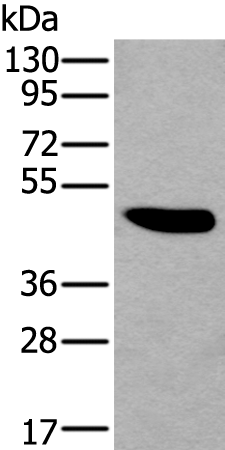

| WB | 1/500-1/2000 | Human,Mouse,Rat |
| IF | 咨询技术 | Human,Mouse,Rat |
| IHC | 1/25-1/100 | Human,Mouse,Rat |
| ICC | 技术咨询 | Human,Mouse,Rat |
| FCM | 咨询技术 | Human,Mouse,Rat |
| Elisa | 1/5000-1/10000 | Human,Mouse,Rat |
| Aliases | PPD; LIBC; PPAC; WISP3; WISP-3 |
| WB Predicted band size | 39 kDa |
| Host/Isotype | Rabbit IgG |
| Antibody Type | Primary antibody |
| Storage | Store at 4°C short term. Aliquot and store at -20°C long term. Avoid freeze/thaw cycles. |
| Species Reactivity | Human, Mouse |
| Immunogen | Fusion protein of human CCN6 |
| Formulation | Purified antibody in PBS with 0.05% sodium azide and 50% glycerol. |
+ +
以下是关于CCN6抗体的3篇参考文献,按文献名称、作者和摘要内容概括列出:
1. **"WISP3 (CCN6) regulates mammary epithelium proliferation and apoptosis"**
- 作者:Huang W, et al.
- 摘要:研究通过免疫组化(使用CCN6抗体)分析乳腺癌组织中CCN6蛋白表达,发现其缺失与肿瘤侵袭性相关,并揭示CCN6通过调控细胞周期和凋亡抑制乳腺癌进展。
2. **"CCN6 modulates BMP signaling via interacting with BMP receptors"**
- 作者:Li J, et al.
- 摘要:利用CCN6特异性抗体进行Western blot和免疫沉淀实验,发现CCN6通过与BMP受体结合调控骨形成和软骨代谢,为骨关节炎治疗提供新靶点。
3. **"Loss of CCN6 promotes epithelial-mesenchymal transition in breast cancer"**
- 作者:Kleer CG, et al.
- 摘要:通过免疫荧光(使用抗CCN6抗体)和基因敲除模型,证明CCN6缺失诱导上皮间质转化(EMT),促进乳腺癌转移,提示其作为转移抑制因子的作用。
如需具体文献年份或期刊,可进一步补充检索条件。
×